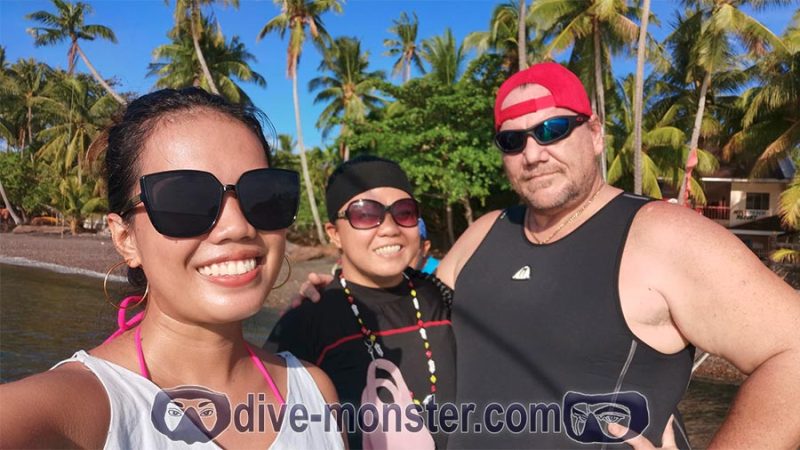DON SHIRLEY SURVIVED that day, but he didn’t walk away unscathed. He emerged from the recompression chamber at Bushman’s, which was pressurized to a depth of 98 feet to shrink the helium bubble in his head, after seven hours, disoriented and barely able to stand. He was so weak that Herbst dragged a mattress over from the police camp so Shirley could sleep right there. Over the next two weeks, he endured ten more chamber sessions, for a total of 27 hours of treatment. It was more than a month before he could think clearly or walk down a crowded street without his perception and balance running haywire. “When I first saw him, I got a hell of a shock,” Andre Shirley says. “He could not walk without support, and his thinking patterns had been affected. He would sound sane, but two minutes later he would forget what he’d said.”
Shirley has improved with time, but the helium bend left him with permanent damage that has impaired his balance. In May he went diving again for the first time, with Peter Herbst hovering protectively alongside. He closed his eyes, turned somersaults, and with relief discovered that the Big Dive had not taken one of the things he loves most. “A cave is a place where I live,” Shirley says.
A week after Shaw died, Gordon Hiles brought the video to a guest house in Pretoria, where Shirley was staying while undergoing recompression treatment at the Eugene Marais Hospital, and Shirley finally watched it. “It was difficult to see, but I really wanted to know firsthand what went on,” he says. Later that day, Shirley took the video to the hospital, where he met with Herbst and Dr. Frans Cronje, medical director of Divers Alert Network Southern Africa, who was overseeing Shirley’s treatment and assisting with the official accident investigation. They watched the video on a large screen and spent hours poring over every detail.
Shirley was so focused on what he was watching that he started mimicking Shaw’s breathing. Then, determined to “see for myself what happened,” Shirley volunteered for an unusual experiment. As Cronje carefully observed, Shirley sat with a CO2 monitor in his mouth and headphones on his ears, watching the video one more time. Every time Shaw breathed, Shirley breathed. Eventually Shirley was huffing through 36 shallow, extremely rapid breaths a minute.
“There was extreme hyperventilation,” Cronje says. “On a rebreather at that depth, it would have been very ineffective.” Shirley’s breathing became so distorted that by the time Shaw faded to just six breaths per minute and then lost consciousness, Shirley was also on the verge of blacking out. His hands were weak and he could barely move. Cronje concluded that Shaw had passed out from carbon dioxide buildup and eventually drowned.
It took Shirley a full half-hour to bring his breathing back under control.
“I actually died with Dave,” he says.
NUNO GOMES is the last person alive today who knows what it’s like to dive to the bottom of Bushman’s Hole, and he understands why Shaw had trouble reacting to a body that was suddenly floating instead of anchored. “You don’t think of a new plan while you are down there. It doesn’t work. Your mind is clouded. You cannot do it,” Gomes says. But he also wonders whether Shaw should have done more buildup dives to increase his tolerance for narcosis—much the way a climber will try to acclimatize to altitude—and his ability to recognize when it reaches dangerous levels. “When he started putting the body in the bag and it didn’t work, he should have immediately turned around and left,” Gomes says.
Gomes is an open-circuit diver, and his priority is setting records. (In June, he reclaimed the world depth record, reaching 1,044 feet in the Red Sea.) “I didn’t think it was worth the risk of a diver losing his life to recover the remains of Deon Dreyer,” he says flatly. Even so, Gomes honors Shaw as a fallen comrade. “It was a noble dive, a heroic dive. He did what he believed in, and I’ve got to say he had a lot of courage,” Gomes says. “At the end of the day, he achieved what he wanted to achieve, even though he paid for it with his life.”
None of the divers who were with Shaw in Bushman’s Hole think the dive was reckless. As support diver Mark Andrews puts it, “If you asked me about the chances before the dive, I’d have said there is a 99 percent chance of success, and a 1 percent chance he’ll have to leave the body. And zero percent that Dave wasn’t coming back.”
Verna van Schaik, who is used to people telling her she is pushing too deep, is sorry Shaw died but not sorry for him. “Dave was going to go back,” she says. “The fact that Deon was there just made it more interesting and more exciting. Dave knew the risks. They were his risks, and he took them.”
Every diver there that day will keep diving, and instead of second-guessing Shaw, they say they are proud of him. “Dave took rebreather diving where it has never been before. People never knew about [rebreathers] until he died showing what can be done,” Peter Herbst says. “Two hundred meters [656 feet] was a damned deep dive on a rebreather. This guy went half as deep again. He made the envelope bigger.”
Ten days after Bushman’s Hole gave the bodies back, Theo and Marie Dreyer went to see their son. When the morgue attendant asked them to step in, Marie wasn’t sure what to expect. When she saw a fully fleshed-out body, her tears stopped, and she felt happy. There was no head, but lying in front of her was her boy. Theo marveled that Deon’s legs still held their athletic shape. Marie couldn’t believe he was still in his Jockey underwear. “We saw him,” she explains, her eyes shining. Overwhelmed, she stepped forward and took her dead son in her arms.
Ann Shaw had hoped her husband would rest forever in Bushman’s Hole. When Herbst called to tell her that his body had been recovered, she was completely unnerved. After some anguish, she decided Shaw’s ashes should be scattered in South Africa, the place he had come to love so much. Ann continues to live and work in Hong Kong. Every once in a while, when she has a problem with the computer, or needs help in the kitchen, she finds herself thinking, Why did you do this to me? Because now I have to do everything. But it’s not anger she feels, just loss. “He needed to dive, and I accepted that,” she says. “I wasn’t about to change him or to tie him down.”
Lisa Shaw, in a eulogy for her father, wrote, “I know having faced death before that my father was unafraid and was completely at peace with the prospect. I know and he knew that the Lord would be right there ready to take him on to new adventures. I am also at peace because he died doing something he loved; very few of us will ever get that privilege.” Steven Shaw, who is 23 and is studying for a master’s degree at the Melbourne College of Divinity, finds some solace that his father died helping others. “But now I’m feeling more just sad that Dad’s gone,” he says.
Shirley misses Shaw, too, and has a picture of himself with Shaw, peering out of a recompression chamber, on his computer’s screen saver. “Dave died exploring and trying to achieve something he wanted to do,” Shirley says. “That to me is better than dying in a car crash.” Still, every day Shirley thinks, Ah, I’ve got to tell Dave that—only to remember that he can’t.
Shaw is not far, though. On a beautiful evening in May, Don and Andre Shirley took a bottle of wine and a small wooden box to the summit of a mountain a short drive from their home. Below them, the rich, pungent grasslands of Mpumalanga swept all the way to the distant horizon, and the Komati River glinted in the golden light. Next to a wild fig tree, the couple raised their glasses in a quiet toast. As the sun dipped low, they opened the box and threw Shaw’s ashes into the air. The ashes hung for an instant, a cloud of a man. Then the African earth took them, and Dave Shaw was gone.









Very interesting read. Thank you for posting them. I am a recreational diver, never tried technical dive. It sounds very interesting and challenging, and requires a lot of safety. I am also surprised that many of the technical divers, especially ones that set major depth records, are quite older in age. I suppose because technical diving requires a lot of experience, much more than say talent in diving.
Hi Leo,
thanks for your comment, you are pretty much correct with your observation about Tech diving. It needs a lot of experience, but it also needs a few dollar more than recreational diving, maybe most need to wait until the kids are out of the house to have the time and money.
anyway, I just got a mail by Phil Finch who wrote a book about the story.
http://dive-monster.com/an-unexpected-mail/
cheers
Rhoody